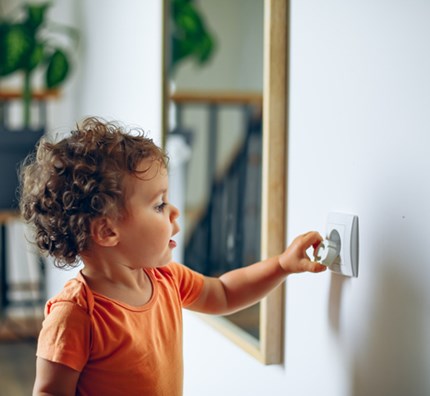A living room can look like the perfect place to relax—until you set a curious toddler down on the floor. In just minutes, an active child can reveal more hazards than you ever imagined.
That’s where childproofing can come to the rescue. Taking steps to remove risks around your home can prevent injuries, important as children become mobile—around the 6-month mark.
Identifying the biggest hazards
According to Cleveland Clinic pediatrician Dr. Kimberly Giuliano, children are most likely to be injured at home, in part because they spend a lot of time there.
Parents, guardians, and caregivers should always be aware of areas in and around the house where accidents are most likely to happen—and where dangerous items can be found.
Think about where children can find:
- Water: in bathrooms, kitchens, swimming pools, hot tubs, fountains, or ponds. [link to water safety blog]
- Heat, flame, or electricity: in kitchens, from fireplaces, outdoor grills, or contact with power outlets.
- Toxic substances: including cleaning supplies, chemicals, and medications, under the kitchen sink, in a medicine cabinet, in a purse, or in the garage or a garden shed.
- Potential for a fall: on stairs, slippery floors, from windows, or from climbing or tipping furniture.
- Items that can strangle, suffocate, or choke: including cords for window blinds, pillows or stuffed animals in cribs, or small household items that can be swallowed.
- Firearms: which should always be stored unloaded in a locked case, with ammunition stored in a separate locked place. Never leave a firearm or ammunition lying around, even if you believe they are out of a child’s reach.
Adding protections around the house
For every home
Make sure you have working smoke and carbon monoxide detectors and a fire extinguisher before you bring your baby home. Lower the temperature of your water heater to 120°F to prevent scalding water.
Outlets and doors
- Install plastic covers to prevent children from sticking objects into electrical outlets.
- Put doorknob covers on doors to rooms you don’t want your child entering. Covers make it hard for little hands to grip, turn, and open doors. It’s a good idea to put covers on doors leading out of your home and on doors to bathrooms and closets.
- Use a tension bar to hold sliding glass doors closed.
Cabinets and drawers
- Use cabinet and drawer locks in the bathroom and kitchen. There are both external and internal locks, and both can be used together for extra protection.
- Remember that cabinet locks are not foolproof and a determined toddler may be able to break them. It’s a good idea to keep cleaning supplies, harmful substances, medicines, and sharp objects in higher places they can’t reach.
Appliances and furniture
- Install a plastic stove guard that protects children from getting burned or accidentally turning on burners. Use the back burners when cooking to reduce the chance of little ones getting burned.
- Cushion sharp corners of furniture with bumpers.
- Secure furniture and appliances to the wall with anchors to keep children from tipping them over.
- Lock appliances and toilet lids so children cannot open them. Locking toilets and using knob covers for bathroom doors can give you layers of protection.
Windows and stairs
- Cut window blind cords, use safety or inner cords, or switch to cordless window coverings to prevent children from getting wrapped up in the strings.
- Use a baby gate at the top and bottom of stairs.
- Make sure windows are locked and use window gates or guards.
You can use this home safety guide from the American Academy of Pediatrics as a childproofing checklist.
Seeing rooms from a child’s point of view
One way to help you childproof a room is to get down on hands and knees to see your house the way a child does. Small items, picture frames, and houseplants can be easy targets for curious children. Look for hazards that can be reached by climbing, like a knife block in the kitchen. Place any items you notice far out of reach.
Continue to check for broken locks or latches after you install them. Look at the floor regularly for small items and toys that younger children can choke on. This includes marbles, balls, un-inflated or broken balloons, small magnets, and small pieces of plastic from toys.
Preventing + preparing to protect an active child
While you can’t cover your child in bubble wrap, you can prevent injuries by paying close attention to your little one and doing a careful job of childproofing in and around your home.
If accidents do happen, you can also be prepared. [link to First 5 blog post on emergencies] Know basic first aid for minor cuts and burns. Have emergency numbers ready before you need them.
If you think a child may have swallowed a household chemical, something poisonous, someone else’s medication, or a small object like a button or battery, call the Poison Control helpline immediately: 1-800-222-1222.

A living room can look like the perfect place to relax—until you set a curious toddler down on the floor. In just minutes, an active child can reveal more hazards than you ever imagined.
That’s where childproofing can come to the rescue. Taking steps to remove risks around your home can prevent injuries, important as children become mobile—around the 6-month mark.
